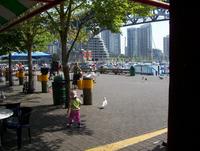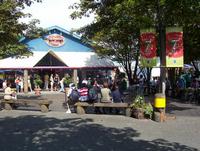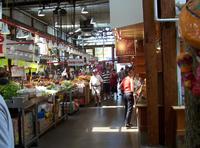granville island
 Today was shopping day: six canvases (on sale), a brush and a tube of cadmium orange. I might find a place to shop closer to home, but I love Granville Island ... and Opus, in all its industrial yellow glory, is by far my favourite art supply store.
Today was shopping day: six canvases (on sale), a brush and a tube of cadmium orange. I might find a place to shop closer to home, but I love Granville Island ... and Opus, in all its industrial yellow glory, is by far my favourite art supply store.I love it here. There is the attraction of the view and the great theatres, shops and restaurants, but I rarely frequent any of those. I pop into the gallery where I show my work, pick up supplies at Opus, then have a stroll along the seawall, stopping at the market for a snack or some produce and to listen to the buskers. And people watch. From tourists to art students, Bag People to Beautiful People, there's never a shortage of human drama. Here's what I dug up about its interesting history:
Granville Island was originally two seaweed-laden sandbars lying half-submerged at the entrance to False Creek (the inlet splitting downtown from the west side). Rich with fish and wildlife, they were the winter fishing grounds of the Squamish Indians. When a bridge linking the north and south shores of False Creek was erected in 1889, the sandbars lying on either side of the bridge's southern end were attractive pieces of real estate.
The sandbars, however, remained in limbo until, in 1915, the newly created Harbour Commission gave Ottawa one dollar for the sandbars and received clearance to reclaim the land. The commission then raised $300,000 to cover the cost of railway tracks and a wooden roadway to False Creek's southern shore.
More than 760,000 cubic metres of sea mud were sucked from False Creek's bed and poured within the island's wooden walls. The mud flats finally transformed into an island. Officially called "Industrial Island," it opened for business in 1916. It was 14.5 hectares in size, three metres above the high-water mark, had 80 lots and rents were $1,200 to $3,700 per hectare, per year.
For the next three decades the island's ironworks, shipyards and various other factories thrived until after the war. A couple of massive fires, the attraction of lower rent industrial areas and the drop off of war production turned it into a squalid, neglected little island that had even lost its status as an island. When a fishermen's terminal was built to the west, the dredging fill was dumped between the island and False Creek's south shore, turning it into a peninsula.
Proponents for urban renewal decided that False Creek needed to change from an industrial area to a more people-friendly urban area. Finally, in 1972 these proponents for change swept to power at city hall and began transforming False Creek and Granville Island. Through the Granville Island Trust, authorities made a commitment to open up the island for a variety of public uses while preserving the industrial character of the old buildings. Rail ties were ripped up, tin cladding taken off and re-applied, foundations reinforced. Old buildings became new.
In July, 1979, the Granville Island public market opened for business to instant success. It encouraged others to come. Today Granville Island is an urban stew whose appeal remains undiminished. It is totally self-supporting and all profits go back into the operation of the island. Its remarkable consistency of architecture has won design awards for Hotson Bakker Architects, the coordinating architects, and others who worked on projects.
The island owes much of its success to its unique relationship with the people of Vancouver. Its lifeblood comes from those who have made Granville Island part of their routine. They have made the Granville Island market the most successful public market in North America. Hundreds of others come down regularly for the theatres, the art school, Arts Umbrella, the community centre and work. And with 2,500 people working there, Granville Island retains its roots as a place of productivity.
(Thanks to Discover Vancouver for most of the info)





2 Comments:
I'm no artist, but I do love artist's materials shops - it feels as though I can sense the potential for all those wonderful works of creation just waiting to be released; as though the paint in the tube is already prepared for it's place on the canvas.
Same thing with timber yards - not only is there the fresh pine smell of new timber (if it's softwood) but it's all just waiting to be made into something, as though time has flowed forwards and then rewound and the creation already exists.
Didn't Michelangelo say something like that, about "releasing" David from the marble?
This looks like such a cool, vibrant place! I really wish we lived in an area where there was such a sense of excitement. I used to get that in NYC, of course, but that's not the kind of stimuli I crave now. I want something a little more laid back, not as self-consciously edgy, and with a bit more of a "crunch" factor. I'm really just an old hippie at heart! We sometimes go to Northampton, MA to hear music and people watch, but it sure isn't as lovely as Granville Island looks. Oh..I also miss being near an ocean :>
Post a Comment
<< Home